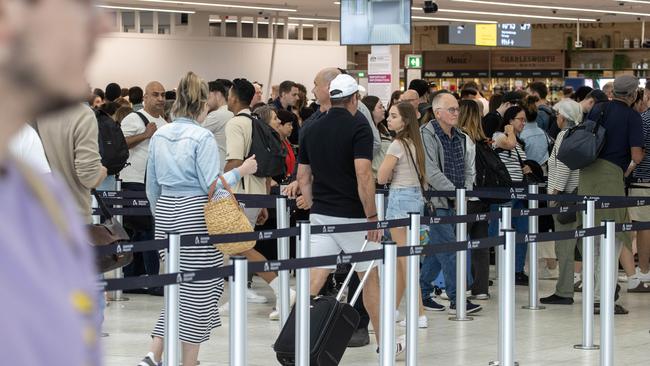Labor’s migration target to be overshot by 100,000
With arrivals outstripping expectations and departures less than anticipated, economists and immigrations experts say Labor will oversee a net migration intake as high as 495,000.

Australia’s net migration target for the last financial year risks being overshot by as much as 100,000, with Labor also likely to eclipse its targets for the current annual intake as ongoing strength in the domestic jobs market keeps workers in Australia and attracts overseas arrivals.
Migration planning levels contained within the May budget projected the net overseas migration intake would fall to 395,000 in the 2023-24 financial year, down from 518,000 in the preceding 12 months.
However, immigration experts and economists say the net overseas migration (NOM) intake – which measures the difference between the number of international arrivals staying longer than 12 months, and the number of long-term and permanent departures – would likely be much higher.
Former immigration department deputy secretary Abul Rizvi predicted the net-migrant intake for 2023-24 would far outstrip Treasury’s projections and would reach around 450,000, and could be as high as 475,000, primarily because of the continued strength of the jobs market.
“That’s attracting people back, especially people in Europe and China and in Southeast Asia, where the labour market has weakened more quickly than in Australia,” Mr Rizvi said.
“What we had was a higher-than-expected return of Australian citizens, and we also had a higher-than-expected net arrival of Kiwis.”
On its most recent measure, Australia’s unemployment rate was 4.1 per cent in August, well outstripped by the OECD average of 5 per cent. In the EU, the key jobless measure was 6 per cent, while in China it was 5.2 per cent.
Also responsible for the higher-than-expected NOM intake was the “slower than anticipated” decline in the number of international students and visa settings for working holidaymakers, which the government had “not really tightened at all”, Mr Rizvi said.
Corinna Economic Advisory’s Saul Eslake, who expected the NOM intake for 2023-24 to be 495,000, “if not more”, said it was just as important to focus on the “quality” of the migration intake, rather than its quantity.
“The Coalition’s right to say there should be more construction trades in the net overseas migration intake, (but) it’s the composition of the intake that matters as much as the absolute number,” he said.
KPMG chief economist Brendan Rynne predicted the NOM intake would reach between 480,000 and 490,000 for 2023-24. “In the two years before Covid, departures averaged around 80,000 per quarter. Over the past two years, this has dropped to 53,000,” Dr Rynne said.
“Had we experienced the average number of departures in 2023-24, the NOM (intake) would have been close to the 395,000 budget outlook figure.”
Jim Chalmers conceded in September that Treasury’s migration planning levels would be missed after the NOM intake reached 388,000 in the first nine months of the 2023-24 financial year. Lower-than-anticipated departures rather than higher-than-expected arrivals was responsible for the overshoot, the Treasurer said.
Mr Rizvi disputed that, saying both inflows and outflows of migrants had caused the NOM intake to be higher than forecast. “The reality is, it’s a bit of both,” he said. “Arrivals have not declined as they expected, departures have not increased as they expected.”
In the years preceding the coronavirus pandemic, Australia’s net overseas migration intake was almost half of current levels, averaging approximately 216,000 a year in the decade to 2019.
Mr Rizvi said given current policy settings, it was “highly unlikely” that NOM planning levels for the current financial year of 260,000 would be met, unless the jobs market sharply deteriorated.
“It seems the Australian labour market is hanging on … while it’s deteriorating, it’s not deteriorating as quickly as other labour markets,” he said.
A further clampdown on international arrivals would also assist Labor to meet its target, Mr Rizvi said, but that window was narrowing: “If they’re going to do further policy tightening to affect this financial year, they’ll have to get a wriggle on.”




To join the conversation, please log in. Don't have an account? Register
Join the conversation, you are commenting as Logout